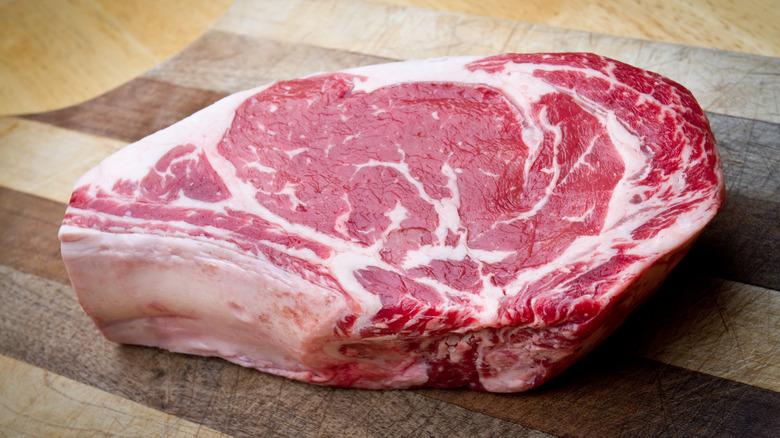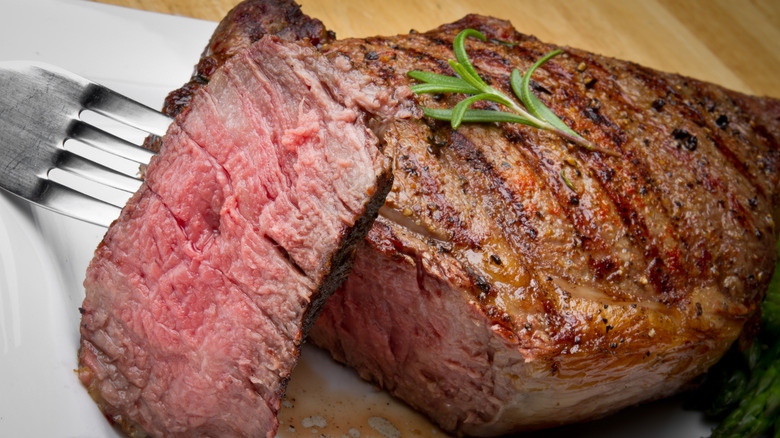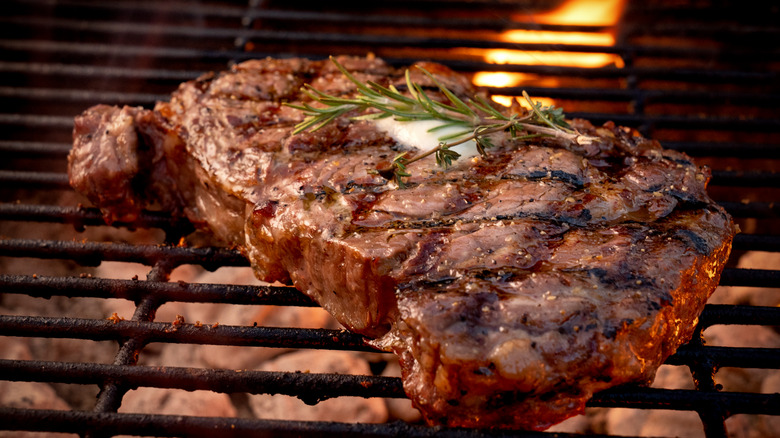Why Ribeye Steak Is The Perfect Cut For Grilling
If you're planning to cook up a top-notch steak dinner on the grill, you've got a few great options for which cuts to use — T-bone, tenderloin, and porterhouse are all great choices, for example. But according to chef Michael Lomonaco from New York City's Porter House, the superior option is a piece of bone-in ribeye (sometimes also called rib steak).
"My favorite cut for the grill is a thick-cut one and a half inch Prime Rib Steak on the bone," Lomonaco told Chowhound in an interview. "A reliably juicy and beefy cut, the marble of fat content adds to the overall great palate-pleaser and the inherent tenderness is always memorable."
It's the marbling that makes ribeye into a steak that grills well: This refers to streaks of fat that run between the red muscles of the steak. It has two main effects on the end product — firstly, the fat helps to make the cooked meat more tender; muscle on its own without fat would be chewier and less palatable. Secondly, it stops the steak from drying out while cooking, as the fat is absorbed into the meat while it grills, making it juicy.
What to know about the ribeye cut
Ribeye steaks are cut from alongside a cow's ribs, usually somewhere between the sixth and twelfth ribs. It comes from a part of the cow that isn't worked out a whole lot, so this makes it particularly tender (in contrast, cuts from areas like the shoulder that are used for a lot of the animal's movement tend to be tougher, and often need slower cooking at a lower heat to get tender). There's some ambiguity about the name of this cut — you may see the term "rib steak" used for a ribeye, although generally speaking (at least in the United States), a "rib steak" has the bone in, and a ribeye is boneless. The bone-in cut may sometimes be called a "cowboy ribeye", too. There's some debate among steak aficionados whether bone-in cuts are more flavorful than boneless ones, but in the case of this cut, both are high-quality steaks.
If you're shopping for ribeyes, you may see terms like "prime," "choice," and "select" in the steak name. These are USDA grades for beef quality: Prime cuts are the top level and should have more marbling (followed by choice and select), but you'll pay a premium for them. But according to Lomonaco, choice cuts are still an excellent choice if you're hoping to save. "In the supermarket, you can often find Choice Rib Steak which is a grade below prime but should not disappoint even the most discriminating diner."
The one downside of ribeye
Even if you opt for the choice cut of ribeye instead of prime grade, you'll still likely end up paying a pretty penny for your steak. Prices will inevitably vary between different butchers and supermarkets, but choice ribeye could cost you $18 or more per pound (with prime going comfortably over $20 per pound). For this reason, Lomonaco warns that if you're new to grilling steak, you may not want to jump straight to expensive cuts like rib steaks while you build up your experience since it's a tricky method to master. "I recommend your steak journey begin with more forgiving and affordable cuts like London broil and chuck steaks before moving into the area of the higher cost rib steaks and strip steaks."
Cuts like chuck steak generally require longer on the grill to cook compared to ribeye (but remember, the thickness of the steak will make a big difference). Since it'll take longer to accidentally overcook a piece of chuck steak, this cuts you a little more slack in the cooking process (compared to ribeye, which may need more precision timing). Either way, it would be smart to use a meat thermometer to figure out when your steak is done, regardless of cut. Chuck steak is a little tougher than ribeye so you may want to marinate it. Once you've developed an intuition for cooking them, you should feel more comfortable stepping up to a fancier cut like ribeye.


